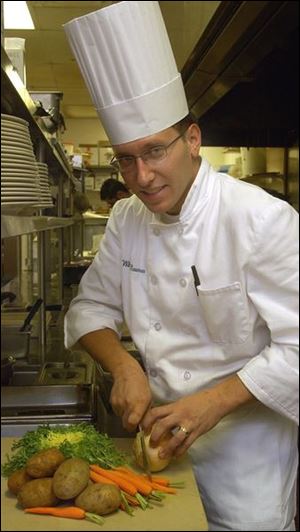
Freshness and flavor
8/12/2003
Braise short ribs with organic vegetables from the Diva kitchen.
Diane Hires / Blade

Braise short ribs with organic vegetables from the Diva kitchen.
In search of quality ingredients, chefs nationwide are buying locally grown and/or organic produce and naturally fed beef, pork, and poultry.
Home cooks can follow in their footsteps.
Whether you consider organic or locally grown products as food treasures or you rely on weekly specials at the supermarket, freshness and flavor are keys to quality.
When William Bauman became executive chef at Diva restaurant this summer, he visited the Toledo Farmers' Market not only for home use but for planning his menu at the restaurant.
“They have great herbs, carrots, potatoes, and tomatoes,” he says. “It helped me see what is seasonal here. I would love to get some of the squash for [Hot and Sour Squash] soup on the menu.” But, he notes, “a lot of the [small] growers don't have weekday deliveries.”
He includes organic items on the menu, such as organic baby carrots, potatoes, and yellow onions that are served with short ribs braised with Guinness and flavored with citrus and cinnamon.
But you won't find mashed potatoes written on the menu. Instead it's “Pomme Puree,” which is served with short ribs. He uses a food mill for the cooked potatoes, but says the home cook can mash them; the recipe is heavy on butter and light on milk.
For baby carrots with tops, he sweats the vegetables with fresh ginger. Buttermilk onion rings are simply dipped in beer-batter flour, then in buttermilk, and back again in beer-batter flour and fried in canola oil until crisp.
With minimal ingredients, preparation is easy enough for the home cook. Presentation is not routine.
When the choice is between organic or locally grown, “I would go for locally grown, if possible,” says the chef, who likes to meet growers at the market. “I enjoy supporting local farmers and growers.”
The advantage of organic produce is that it is chemical-free. “You don't have to worry about pesticides” and growers use natural fertilizer, says the graduate of the Culinary Institute of America.
Items must be available in amounts needed for commercial cooking, however. If they are not, chefs must turn to commercial vendors, mail-order sources, and specialty gardens such as the Chef's Garden in Huron, Ohio. Chef Bauman will use organic growers in southwest Ohio.
Organic produce can be comparable in appearance to mass- produced items. “Some people have the notion that you can't grow the same size vegetables organically, but you can,” Chef Bauman says. “You can tell the difference in organically produced versus mass produced by mouth-feel. The organic product is smoother and juicier. The color is more vibrant because it gets excellent sun, grows longer, is hand-picked, and is vine-ripened.”

Cheg William Bauman with organic vegetables.
However, organic produce and heirloom items such as tomatoes are not known for perfect beauty. The tomatoes may not be the same red color and there may be cracks and fissures in the skin, indicating juiciness and plump ripeness.
Mr. Bauman came to Diva from Aureole restaurant in Las Vegas.
Locally raised or grown foods are gaining as much attention as organic products.
At the Toledo Farmers' Market, Ohio Signature Beef is the brand of beef sold by Great Lakes Family Farms, a group of 14 growers in Wood County.
While the Ohio Proud product sold at the Toledo Farmers' Market is frozen, retail outlets for fresh meat are planned at Fisher Foods in Canton, Zagara's in Cleveland Heights, and Kirbie's Meats and Catering in Stow. Gabriel Stoller, brand manager, anticipates a retail outlet in Toledo soon.
The animals are corn-fed, which “adds marbling” to the meat, says Mr. Stoller. “It's that hearty beefy flavor.”
But the product is not organic. “To be certified, all cattle must be raised on certified organic pasturelands and fed certified organic feed,” he says. “That is cost prohibitive.”
“Our beef is raised without antibiotics and hormones. It's dry-aged, which adds flavor and increases tenderness.”
Mr. Stoller says he has been talking to a couple of restaurants and a local country club about using the product, perhaps one cut of beef initially. “We're small enough, it may be difficult. They may order 200 steaks a week, which could be our total supply,” says Mr. Stoller, who estimates that in a year Great Lakes Family Farms expects to be ready to supply such larger orders of Ohio Signature Beef.
Great Lakes Family Farms did furnish 10,000 Ohio Signature Beef hot dogs and 10,000 hamburgers for the Toledo Area Metroparks 75th anniversary picnic on July 12, says Larry Warns, president of Great Lakes Family Farms.
Meanwhile, local supermarkets are giving more shelf space to organic and naturally grown or produced products.
Churchill's Briarfield Market includes organic produce, locally grown produce, and specialty items such as Coleman meats, which are antibiotic-free and hormone-free, and Nieman Ranch beef, according to vice president Bill Stimmel.
Among the lineup of cooking demonstrations at Churchill's Briarfield Market, assistant produce manager Chad Kujawa presents Exploring Produce with Chad from noon to 2:30 p.m. each Sunday.
Each week, he features seasonal produce. Last Sunday, he made corn and tomato salsa, and cooked home-grown cabbage and zesty baked zucchini.
This Sunday, he has scheduled tofu stir fry using fresh sugar snap peas, summer squash, fresh bean sprouts, and bell peppers. There will also be a veggie tray sampling, which should include traditional veggies as well as some less known items such as jicama and bok choy. He will also have a sampling of boiled bicolor corn on the cob.
“People like to sample,” says Mr. Kujawa. “They like the recipes and learning about how to cook different things.”
When June McCarthy demonstrated recipes at the Meijer store on West Central Avenue in July, she used the store's Ohio-grown produce, including corn, greens, tomatoes, and summer squash.
“Any time you shorten the time between picking and cooking, it can only be better,” says Ms. McCarthy, Ohio's state chef representing Ohio Proud products. “You want to use the best, freshest ingredients to improve flavor and quality.”
Braised Mixed Greens with Bacon, a delicious use of collard, mustard, and turnip greens, was cooked in chicken stock instead of water to enhance flavor. Shoppers stopped to watch, taste, and collect recipes.
What better place to learn about ingredients than a farmers' market, the produce department of local stores, or watching what local chefs are dishing up?
For more stories on food, see www.toledoblade.com/food.